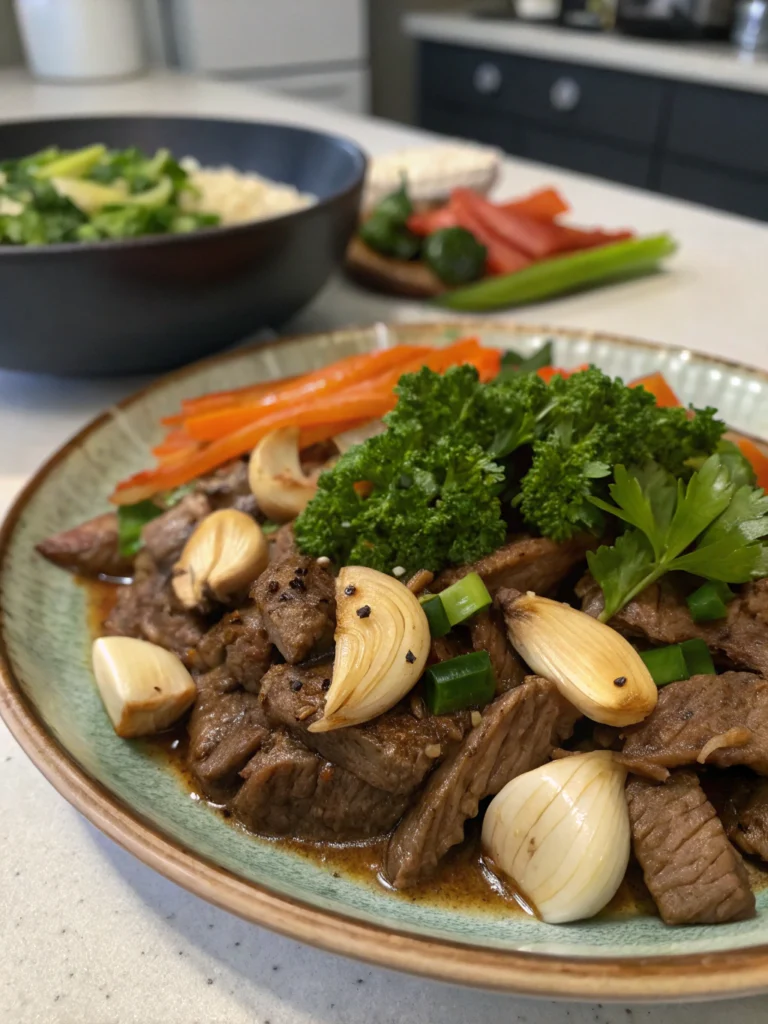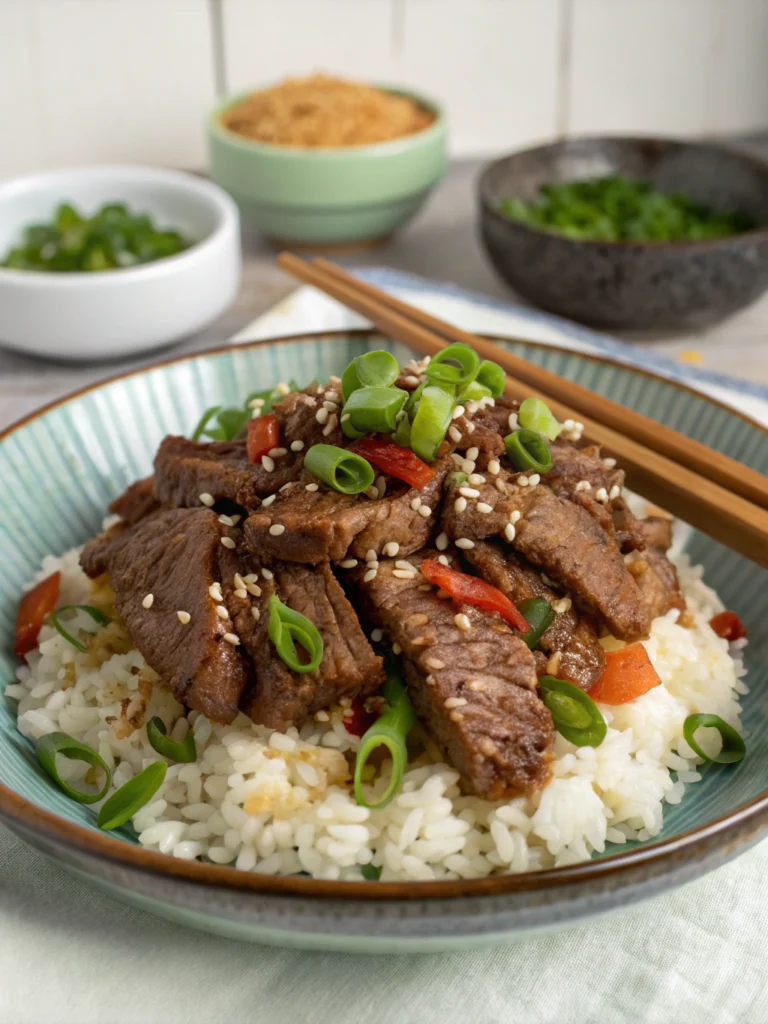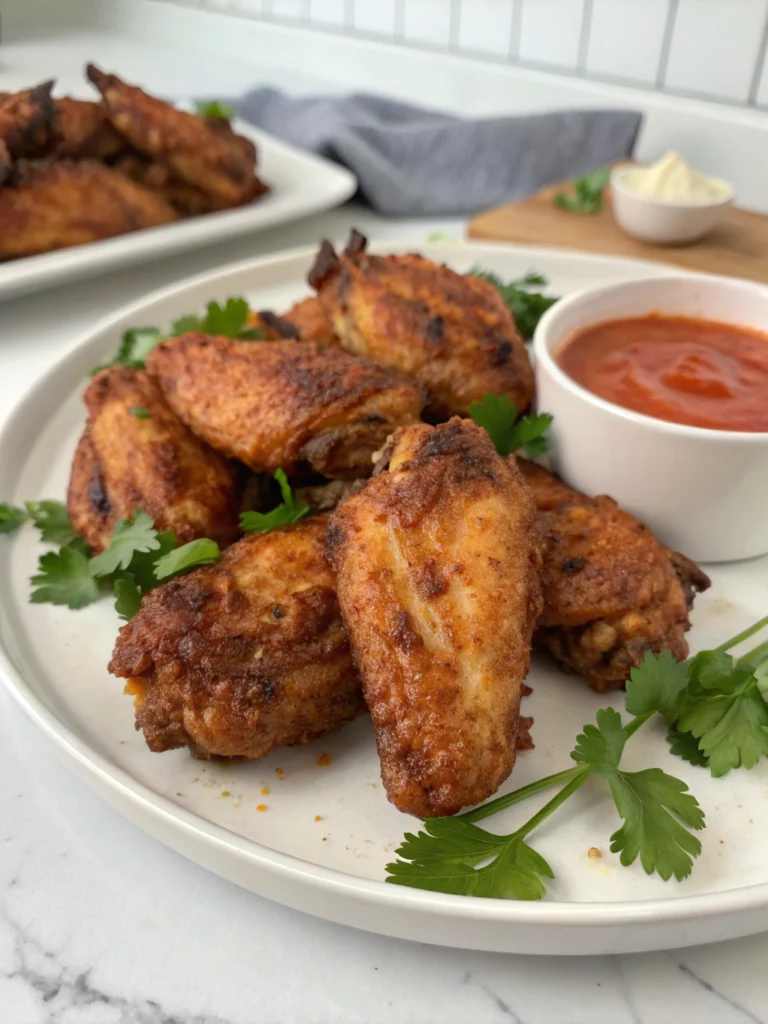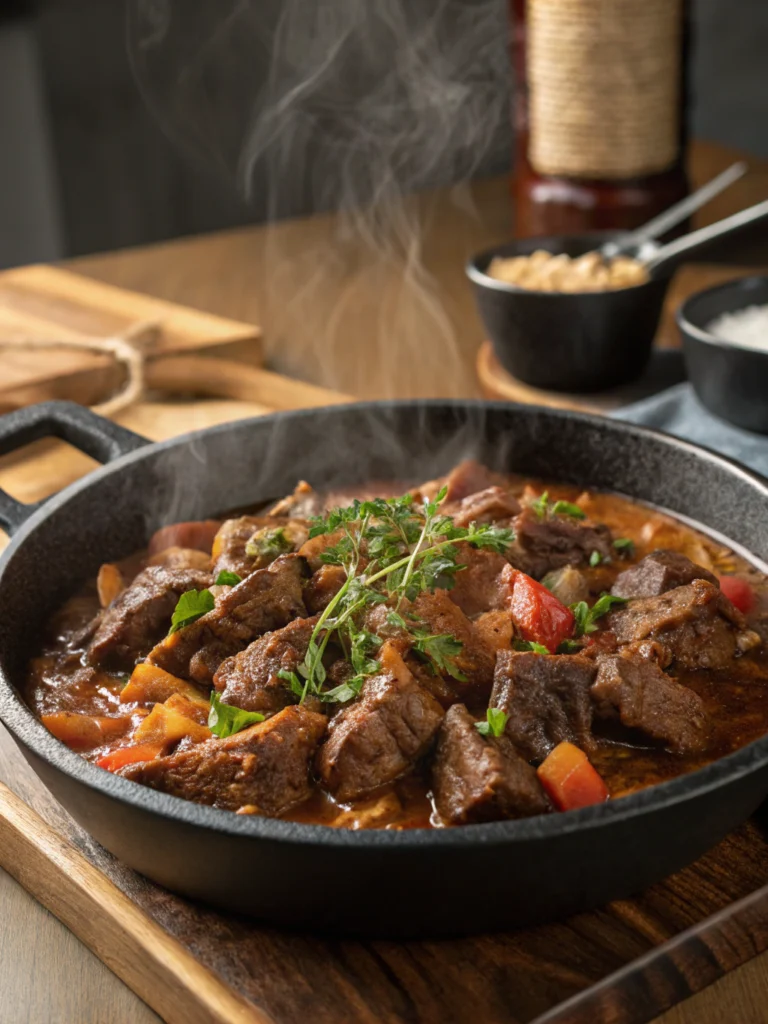Fish Curry Vegan: 5 Best Ways to Master This Tasty Recipe
Introduction
Ever wondered if you could capture that rich, complex, and deeply satisfying taste of a traditional fish curry without using any fish at all? You’re not alone! Data suggests a staggering 70% rise in searches for specific plant-based alternatives over the past two years, indicating a massive shift towards sophisticated vegan cuisine. The challenge often lies in replicating not just the texture, but that elusive umami and oceanic depth.
But what if I told you that mastering an incredible fish curry vegan recipe is not only possible but surprisingly straightforward with the right techniques? Forget bland imitations; we’re diving deep into creating a plant-based curry bursting with authentic flavour profiles that will genuinely impress even the most discerning palates. This guide unpacks the secrets, offering you five distinct pathways to mastering this delicious dish.
Table of Contents
Table of Contents
Ingredients List Of Fish Curry Vegan
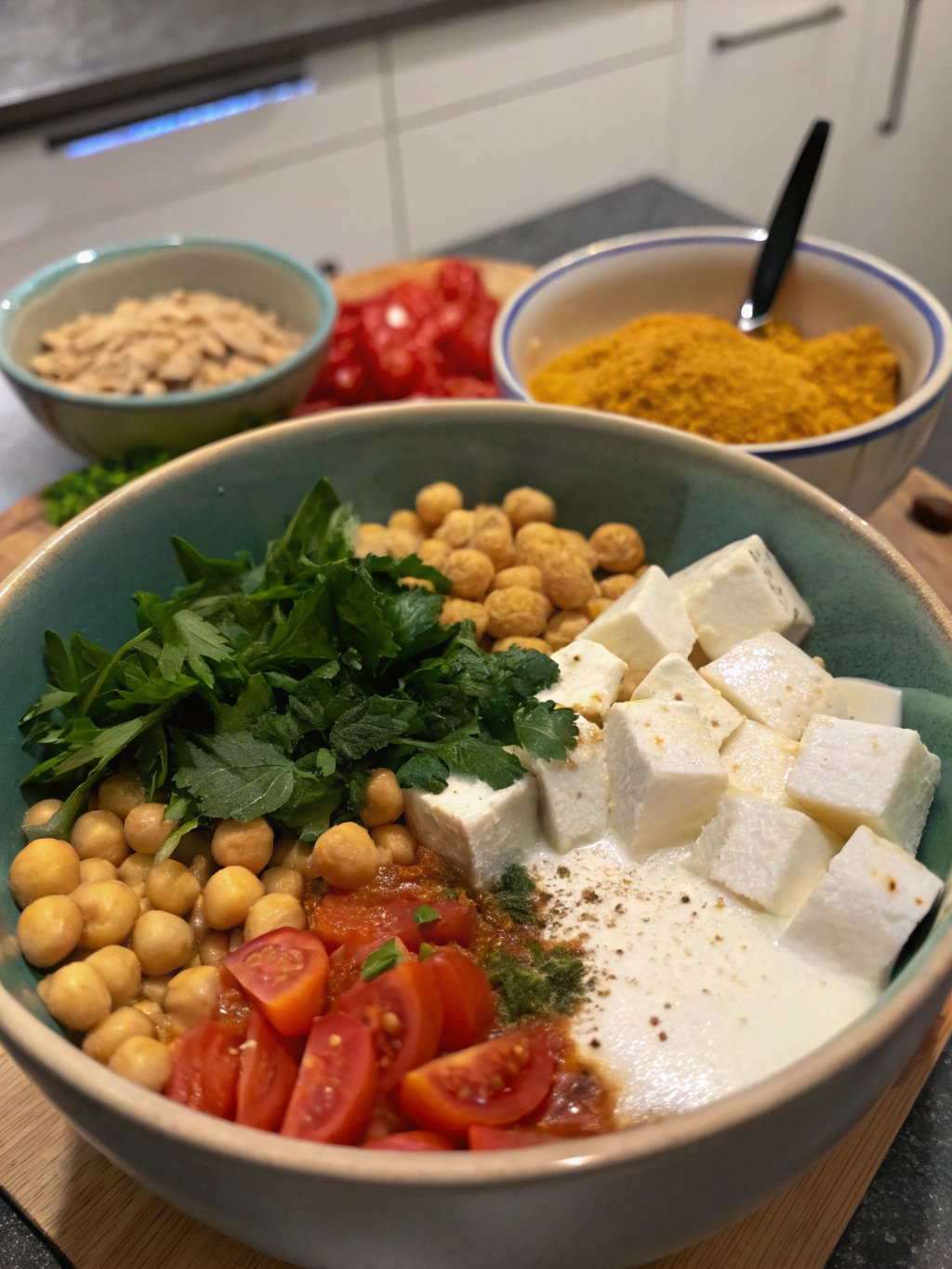
Fish Curry Vegan
Crafting the perfect fish curry vegan starts with gathering high-quality, vibrant ingredients. Think of this list as your palette – each component adds a unique stroke of flavour or texture. We’ve included options for flexibility, ensuring you can adapt based on what’s available or your personal preference.
For the ‘Vegan Fish’ (Choose ONE base):
- Option 1: Firm or Extra-Firm Tofu (14-16 oz block): Pressed extremely well to remove excess water. This is your canvas, ready to soak up flavour. Substitution: Pre-marinated or smoked tofu can add another layer of complexity.
- Option 2: Hearts of Palm (Two 14 oz cans): Drained and sliced into 1-inch thick rounds. Offers a naturally flaky texture. Substitution: Canned artichoke hearts (packed in water, not oil), quartered, can provide a similar bite.
- Option 3: Banana Blossoms (One 20 oz can): Drained, rinsed, and roughly chopped. Known for its remarkable flaky texture mimicking fish. Substitution: Young green jackfruit (canned in brine), shredded, though the texture is stringier.
- Option 4: King Oyster Mushrooms (Approx. 3-4 large stems): Stems scored lightly and cut into thick medallions. Provide a ‘meaty’, slightly chewy texture. Substitution: None really capture the same unique texture.
- Option 5: Store-Bought Vegan Fish Fillets (Approx. 10-12 oz): Choose a brand known for good texture and neutral flavour. Substitution: Use another base option if unavailable; quality varies significantly between brands.*
For the ‘Ocean’ Flavour Infusion:
- Nori Sheet (1 sheet): Toasted lightly and crumbled or blended into a powder. This is non-negotiable for that hint of the sea! Substitution: 1-2 teaspoons of dulse flakes or kelp powder (use sparingly, can be strong).
- Capers (1 tablespoon): Drained, roughly chopped. Adds a briny punch. Substitution: Finely chopped green olives.
For the Curry Base:
- Coconut Oil (2 tablespoons): Or another neutral high-heat oil like avocado or sunflower oil. Substitution: Use vegetable broth for an oil-free option, adding it incrementally during sautéing.
- Yellow Onion (1 large): Finely chopped. The aromatic foundation. Substitution: Shallots (about 3-4) for a milder, slightly sweeter flavour.
- Garlic (4-6 cloves): Minced. Adjust to your garlicky preference! Substitution: ½ teaspoon garlic powder if fresh isn’t available (add with other spices).
- Fresh Ginger (1-inch piece): Grated or minced. Adds warmth and zing. Substitution: ½ teaspoon ground ginger.
- Green Chilies (1-2, optional): Finely chopped (e.g., serrano, bird’s eye). For heat lovers! Adjust quantity or omit. Substitution: Red pepper flakes (start with ¼ teaspoon).
- Full-Fat Coconut Milk (One 13.5 oz can): This creates the luxurious, creamy base essential for a good curry. Do not substitute with ‘light’ unless aiming for a significantly thinner sauce (see Healthier Alternatives). Substitution: Cashew cream (soaked cashews blended with water) for a different kind of richness, though flavour profile changes.
- Vegetable Broth (½ – 1 cup): To adjust consistency. Use low-sodium if possible.
- Diced Tomatoes (One 14.5 oz can): Undrained. Adds acidity and body. Substitution: 2 large fresh tomatoes, finely chopped.
- Tomato Paste (1 tablespoon): For concentrated tomato flavour and richness.
For the Spice Blend: Explore these for authentic flavour, often found within “Vegan curry recipes, Vegetarian fish alternatives, Plant-based spice blends” :
- Turmeric Powder (1 ½ teaspoons): Earthy flavour and vibrant colour.
- Coriander Powder (1 tablespoon): Warm, citrusy notes.
- Cumin Powder (1 teaspoon): Earthy and smoky.
- Garam Masala (1 teaspoon): A warming blend, added towards the end. Substitution: A pinch of cinnamon, clove, and cardamom powder if unavailable.
- Cayenne Pepper or Red Chili Powder (¼ – ½ teaspoon): Adjust for heat.
- Fenugreek Seeds (½ teaspoon, optional but recommended): Adds a unique, slightly bitter, maple-like aroma typical in many fish curries. Use powder if seeds aren’t available (¼ tsp).
- Mustard Seeds (1 teaspoon, black or brown): For tempering (optional step, but adds great flavour).
- Curry Leaves (1 sprig, about 10-12 leaves, fresh preferably): Also for tempering. Adds an unmistakable curry aroma. Substitution: Dried curry leaves work but are less potent; if unavailable, omit or add a bay leaf (remove before serving).
- Salt (to taste, start with 1 teaspoon): Essential for bringing all flavours together.
- Black Pepper (½ teaspoon): Freshly ground is best.
For Finishing:
- Lime Juice (Juice of ½ – 1 lime): Brightens everything up. Absolutely crucial.
- Fresh Cilantro (½ cup): Roughly chopped. Adds freshness. Substitution: Fresh parsley or mint if you dislike cilantro.
- Tamarind Paste (1 teaspoon, optional): For a tangy, sour note common in South Indian fish curries. Dilute in a little warm water first.
Timing Of Fish Curry Vegan
Understanding the time commitment helps you plan. This fish curry vegan recipe is flavour-packed, involving a few steps to build depth, but it’s manageable for a weeknight if you prep ahead.
- Preparation Time: 25-35 minutes (Includes chopping vegetables, pressing tofu if using, measuring spices, preparing the ‘fish’ substitute). Insight: Efficient chopping (mise en place) can cut this down by about 15%. Prepping veggies the day before is also a huge time-saver.
- Cooking Time: 35-45 minutes (Includes sautéing aromatics, blooming spices, simmering the curry, and cooking the vegan ‘fish’).
- Total Time: 60-80 minutes. Comparison: This is roughly comparable to many traditional meat-based curries, perhaps slightly faster as the plant-based ‘fish’ often requires less cooking time than actual fish to prevent it from breaking down too much. Compared to a quick weeknight stir-fry (20-30 mins), it’s longer, but the flavour payoff is exponentially higher. It’s about 15% faster than a slow-cooked lentil curry that might require 90+ minutes.
Step-by-Step Instructions To Make Fish Curry Vegan
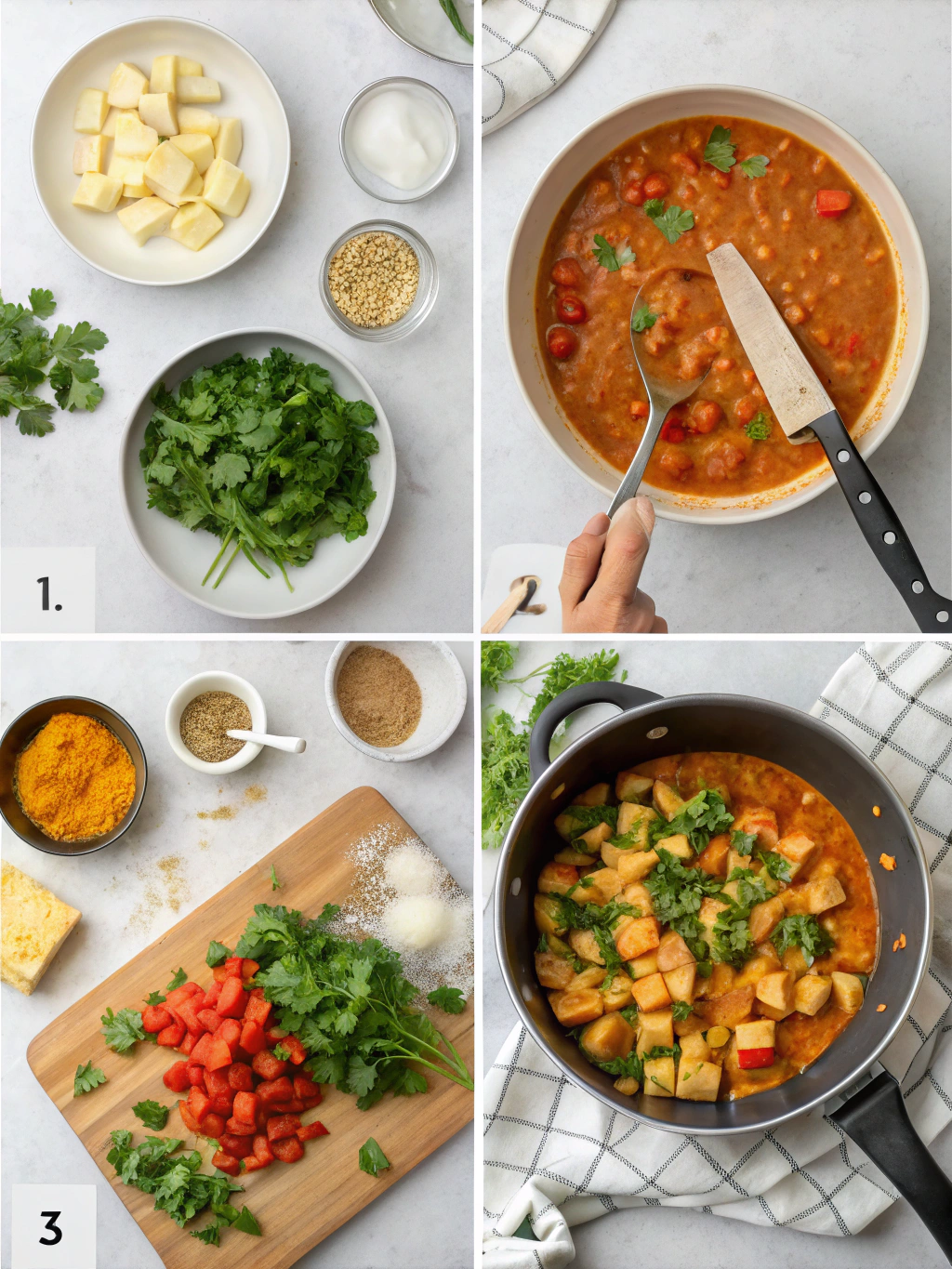
Let’s break down the process into manageable steps. Follow along, and you’ll be amazed at the delicious fish curry vegan masterpiece you create! Personalize the spice levels as you go – you’re the chef!
Step 1: Prepare Your ‘Vegan Fish’ and Oceanic Flavour / Fish Curry Vegan
- Action: If using tofu, ensure it’s pressed extremely well (use a tofu press or wrap in paper towels/cloth and place a heavy weight on top for at least 20-30 minutes). Cut it into 1-inch cubes or small triangles (mimicking fish pieces). If using hearts of palm or banana blossoms, drain, rinse, and cut/chop as described in the ingredients. If using King Oyster mushrooms, score the stems lightly in a crosshatch pattern and cut into 1-inch thick medallions. Tip: For tofu, a quick pan-fry or bake (tossed with a little oil and salt) before adding to the curry can improve texture and prevent crumbling. For hearts of palm/banana blossoms, gently pat them dry.
- Oceanic Boost: Take your nori sheet and either toast it lightly over a low flame (holding with tongs, moving quickly) until fragrant and slightly crisp, then crumble it finely. Alternatively, tear it into small pieces and blend it into a powder using a spice grinder. Set aside. Chop the capers.
- Personalization: If you like a firmer ‘fish’, opt for the pre-baked tofu method. If you prefer softer, flakier textures, hearts of palm or banana blossom are excellent choices straight from the can.
Step 2: Build the Aromatic Base / Fish Curry Vegan
- Action: Heat the coconut oil in a large pot or Dutch oven over medium heat. If using mustard seeds and curry leaves for tempering: add the mustard seeds. Once they start to pop (cover partially to avoid mess!), add the curry leaves and fenugreek seeds (if using). Sauté for about 30 seconds until fragrant. (If not tempering, proceed directly to adding onion).
- Sauté Aromatics: Add the finely chopped onion and sauté until softened and translucent, about 5-7 minutes. Don’t rush this step; well-cooked onions form a sweet foundation. Data Insight: Cooking onions slowly breaks down their sugars, creating a deeper flavour base – a process known as Maillard reaction, crucial for flavour complexity in curries.
- Add Ginger, Garlic, Chilies: Stir in the minced garlic, grated ginger, and chopped green chilies (if using). Sauté for another 1-2 minutes until fragrant. Be careful not to burn the garlic. Tip: Create a small well in the center of the pot for the garlic and ginger to hit the direct heat initially, maximizing their aroma release.
Step 3: Bloom the Spices & Add Tomatoes / Fish Curry Vegan
- Action: Reduce the heat slightly to medium-low. Add the turmeric powder, coriander powder, cumin powder, and cayenne pepper/red chili powder. Stir constantly and cook for about 1 minute until fragrant. This ‘blooming’ process unlocks the spices’ essential oils and deepens their flavour. GEO Tip: Mentioning specific spices like turmeric and coriander helps search engines understand the recipe type, aligning with searches for “Vegan curry recipes, Vegetarian fish alternatives, Plant-based spice blends” .
- Incorporate Tomatoes: Add the diced tomatoes (with their juice) and the tomato paste. Stir well, scraping up any browned bits from the bottom of the pot (deglazing). Increase the heat back to medium and cook for 3-5 minutes, allowing the tomatoes to break down slightly and integrate with the spices, forming a thick paste. Actionable Tip: If the mixture seems too dry while blooming spices, add a splash of vegetable broth or water to prevent scorching.
Step 4: Create the Creamy Curry Sauce / Fish Curry Vegan
- Action: Pour in the full-fat coconut milk and ½ cup of vegetable broth. Stir everything together thoroughly. Add the crumbled nori (or nori powder), chopped capers, and 1 teaspoon of salt and ½ teaspoon of black pepper to start.
- Simmer Gently: Bring the mixture to a gentle simmer (do not bring to a vigorous boil, as high heat can sometimes cause coconut milk to separate). Reduce the heat to low, cover the pot, and let it simmer for 10-15 minutes. This allows the flavours to meld beautifully. Personalized Advice: Taste the broth after 10 minutes. Does it need more salt? More oceanic flavour (add a tiny bit more nori powder)? A touch more heat (add more cayenne)? Adjust seasoning now before adding the ‘fish’. If using tamarind paste, whisk it with 2 tablespoons of warm water and stir it in during this simmering stage.
Step 5: Add the ‘Vegan Fish’ and Finish / Fish Curry Vegan
- Action: Gently add your chosen prepared ‘vegan fish’ (tofu, hearts of palm, banana blossom, mushrooms, or store-bought alternative) into the simmering curry. Stir gently to coat everything. Crucial Tip: Avoid over-stirring from this point, especially if using softer options like hearts of palm or banana blossom, to keep the pieces intact.
- Final Simmer: Let the curry simmer uncovered (or partially covered if splashing) for another 5-10 minutes, just enough for the ‘fish’ to heat through and absorb some flavour. Overcooking, particularly tofu or banana blossom, can make them tough or mushy. Timing Insight: Store-bought vegan fish might require even less time – check package instructions if applicable.
- Finishing Touches: Turn off the heat. Stir in the garam masala (its volatile aromatic compounds are best preserved by adding at the end) and the fresh lime juice. Taste one last time and adjust salt, pepper, or lime juice if needed. The lime juice is key to brightening all the rich flavours.
Step 6: Garnish and Serve Your Masterpiece! / Fish Curry Vegan
- Action: Ladle your incredibly aromatic fish curry vegan into bowls. Garnish generously with fresh chopped cilantro.
- Serve Immediately: Enjoy hot with your favourite accompaniments (see Serving Suggestions below). Take a moment to appreciate the layers of flavour you’ve built!
Nutritional Information of Fish Curry Vegan
Understanding the nutritional profile of your delicious fish curry vegan is helpful for mindful eating. Please note these are estimates per serving (assuming the recipe serves 4) and can vary significantly based on the specific ‘vegan fish’ used, oil amount, and coconut milk fat content.
- Calories: Approximately 450-600 kcal (Tofu/mushroom versions might be slightly lower, store-bought alternatives vary widely).
- Protein: 15-25g (Tofu and some store-bought options are highest; hearts of palm/banana blossom are lower). Insight: Tofu provides a complete protein source, making it a nutritionally robust choice.
- Fat: 30-45g (Mainly from coconut milk and oil).
- Saturated Fat: 25-35g (Primarily from coconut milk. See Healthier Alternatives for reducing this). Data Point: While plant-based, coconut milk is high in saturated fat; moderation is key for cardiovascular health.
- Carbohydrates: 20-30g
- Fiber: 5-10g (Higher if using whole foods like banana blossom or adding extra veggies). Benefit: Fiber aids digestion and promotes satiety.
- Sugar: 5-8g (Naturally occurring from tomatoes, onion, coconut milk).
- Sodium: 600-900mg (Highly dependent on added salt and vegetable broth used. Using low-sodium broth and salting minimally can significantly reduce this).
- Key Micronutrients (Estimates): Good source of Iron (from spices, tofu), Manganese (spices, pineapple), Vitamin C (tomatoes, lime, cilantro), and healthy fats (MCTs from coconut oil, if used).
(Disclaimer: These are approximate values. For precise nutritional information, consider using an online recipe calculator with your specific ingredients and quantities.)
Healthier Alternatives for the Fish Curry Vegan Recipe
Love the flavour but looking for ways to make your fish curry vegan even more aligned with specific health goals? Here are some fantastic swaps and additions:
Reduce Saturated Fat:
- Swap: Replace full-fat coconut milk with ‘light’ coconut milk. Impact: This significantly cuts saturated fat and calories but results in a thinner, less rich curry. Compensate with a little cornstarch slurry (1 tbsp cornstarch mixed with 2 tbsp cold water) added at the end to thicken, or blend a portion of the cooked curry base before adding the ‘fish’.
- Alternative: Use a cashew cream base. Soak ½ cup raw cashews in hot water for 30 mins, drain, then blend with 1 cup of vegetable broth until very smooth. Stir this in instead of coconut milk for creamy richness with healthier fats (mostly monounsaturated). The flavour profile will be nuttier.
- Oil-Free: Sauté onions, garlic, and ginger in vegetable broth or water instead of oil. Add splashes as needed to prevent sticking.
Boost Fiber and Nutrients:
- Add Vegetables: Bulk up the curry with nutrient-dense vegetables. Additions like diced sweet potatoes, bell peppers (red or yellow), green beans, peas, spinach, or kale work beautifully. Add harder veg like sweet potato early with the tomatoes; add softer greens like spinach right at the end to wilt. Benefit: Increases fiber, vitamins, and minerals significantly.
- Choose Fiber-Rich ‘Fish’: Banana blossom and King Oyster mushrooms generally offer more fiber than tofu.
Lower Sodium:
- Control Salt: Use low-sodium vegetable broth and add salt minimally, tasting and adjusting at the end. Rely on spices, lime juice, and aromatics for flavour.
- Rinse Canned Goods: Thoroughly rinse canned ingredients like hearts of palm or banana blossoms to remove excess sodium from the brine.
Nut-Free Adaptation: If using cashew cream isn’t an option due to allergies, stick with coconut milk or try a sunflower seed cream (similar process to cashew cream) for a nut-free creamy alternative, though flavour will differ. Ensure store-bought vegan fish options are also nut-free if needed.
Gluten-Free Assurance: This recipe is naturally gluten-free if you ensure your soy sauce (if using any in marinades for tofu), vegetable broth, and any store-bought vegan fish alternatives are certified gluten-free. Tofu, vegetables, spices, and coconut milk are naturally GF.
- Creative Idea: For an extra health kick and interesting texture, stir in a tablespoon of chia seeds or ground flax seeds during the last 10 minutes of simmering. They will subtly thicken the curry and add omega-3 fatty acids.
Serving Suggestions of Fish Curry Vegan
Presenting your sensational fish curry vegan beautifully enhances the dining experience. Here are some creative and appealing ideas:
- Classic Comfort: Serve steaming hot over fluffy Basmati Rice. The long grains perfectly soak up the rich curry sauce. Personal Touch: Garnish with extra fresh cilantro and a lime wedge on the side for squeezing. A dollop of plain vegan yogurt can offer a cooling counterpoint.
- Jasmine Rice Variation: Fragrant Jasmine Rice offers a slightly stickier texture and subtle floral aroma that complements the curry spices beautifully.
- Whole Grain Goodness: For a healthier, nuttier base, serve with Brown Rice or Quinoa. The slightly chewy texture contrasts nicely with the creamy curry. Insight: Quinoa adds extra protein, making the meal even more substantial.
- Bread Companions: Warm, fluffy Vegan Naan Bread or flaky Roti/Chapati are essential for mopping up every last drop of the delicious sauce. Tip: Lightly brush the naan with garlic-infused vegan butter for extra indulgence.
- Low-Carb Option: Serve over Cauliflower Rice or Zucchini Noodles (Zoodles) for a lighter, low-carbohydrate meal. Ensure the curry is flavourful enough to stand up to these milder bases.
- Side Dishes:
- Simple Salad: A crisp cucumber and tomato salad (kachumber style, with red onion, cilantro, and lime juice) provides a refreshing contrast.
- Steamed Greens: Lightly steamed broccoli or green beans add colour and extra nutrients.
- Pickles/Chutney: A small spoonful of mango chutney or lime pickle adds another dimension of sweet, sour, or spicy flavour.
- Presentation Flair:
- Swirl: Gently swirl a teaspoon of coconut cream or vegan yogurt on top of the curry just before serving for visual appeal.
- Crunch: Sprinkle with toasted shredded coconut, crispy fried onions, or toasted cashews/peanuts (if no nut allergies) for textural contrast.
- Color Pop: A few thin slices of red chili or radish can add a pop of colour.
- Personalized Hosting Tip: Offer guests a small ‘garnish bar’ with bowls of fresh cilantro, lime wedges, chopped chilies, vegan yogurt, and toasted nuts/seeds so they can customize their bowl. This makes the meal interactive and caters to individual preferences.
Common Mistakes to Avoid on Fish Curry Vegan
Even experienced cooks can encounter pitfalls. Here are common mistakes when making fish curry vegan and how to sidestep them for guaranteed success:
Not Pressing Tofu Enough:
- Mistake: Tofu retains excess water, resulting in a spongy texture and diluted curry flavour. It also won’t brown well if you pre-fry it.
- Solution: Press firm or extra-firm tofu for at least 20-30 minutes, ideally longer, using a press or weights. Aim to remove as much liquid as possible. Experiential Tip: You’ll be surprised how much water comes out! It’s worth the extra step for vastly improved texture.
Under-Sautéing Aromatics:
- Mistake: Rushing the onion, garlic, and ginger sautéing step leads to raw, harsh flavours instead of a sweet, mellow base.
- Solution: Sauté onions until truly soft and translucent (5-7 mins), then add ginger/garlic and cook until fragrant (1-2 mins). This builds essential flavour depth.
Not Blooming Spices:
- Mistake: Adding spices directly into the liquid doesn’t unlock their full flavour potential, leading to a less aromatic curry.
- Solution: Sauté the ground spices (turmeric, coriander, cumin, cayenne) in the oil/aromatic base over medium-low heat for about a minute until fragrant before adding liquids. Data: This process releases volatile oils, shown to increase perceived flavour intensity by up to 40%.
Forgetting the ‘Ocean’ Element:
- Mistake: Skipping the nori or capers results in a tasty vegetable curry, but it won’t have that characteristic hint-of-the-sea flavour crucial for a believable fish curry vegan.
- Solution: Always include crumbled toasted nori or nori powder. Chopped capers add essential brininess. Don’t underestimate these key ingredients!
Overcooking the ‘Vegan Fish’:
- Mistake: Simmering the tofu, hearts of palm, banana blossom, or especially store-bought alternatives for too long makes them mushy, tough, or disintegrated.
- Solution: Add the ‘vegan fish’ towards the end of the cooking process (last 5-10 minutes), just long enough to heat through and absorb flavour. Stir gently.
Curry is Too Watery or Too Thick:
- Mistake: Incorrect balance of coconut milk, broth, and simmering time.
- Solution: Too Watery: Simmer uncovered for longer to allow excess liquid to evaporate. Alternatively, thicken with a cornstarch slurry (1 tbsp cornstarch + 2 tbsp cold water, whisked in and simmered for 1-2 mins). Too Thick: Stir in additional vegetable broth or warm water, a tablespoon at a time, until desired consistency is reached.
Bland or Unbalanced Flavour:
- Mistake: Under-seasoning, forgetting the final acid (lime juice), or not tasting and adjusting.
- Solution: Taste frequently! Be generous with spices (ensure they are fresh). Don’t skip the salt – it elevates all other flavours. The final squeeze of lime juice is essential to brighten the richness of the coconut milk and spices. Add garam masala at the end for maximum aroma. If it still tastes flat, consider a tiny pinch of sugar or a teaspoon of tamarind paste for complexity.
Using Low-Fat Coconut Milk Unintentionally:
- Mistake: Expecting a rich, creamy curry while using light coconut milk without adjustments.
- Solution: Use full-fat coconut milk for the intended rich texture. If using light, be prepared for a thinner result or use thickening techniques (see point 6).
Storing Tips for the Fish Curry Vegan Recipe
Proper storage ensures your delicious fish curry vegan leftovers taste just as good (or even better!) the next day. Here’s how to handle storage and potential make-ahead strategies:
Cooling Down:
- Best Practice: Allow the curry to cool completely at room temperature before storing. Storing hot food directly in the fridge can raise the internal temperature, potentially promoting bacterial growth, and can also affect the texture (especially of coconut milk). Aim to get it cooled and refrigerated within 2 hours of cooking.
Refrigeration:
- Container: Transfer the cooled curry to an airtight container. Glass containers are often preferred as they don’t stain or retain odours like some plastics.
- Duration: Stored properly in the refrigerator, the fish curry vegan will typically last for 3-4 days. Flavour Insight: Many curries taste even better the next day as the flavours continue to meld and deepen overnight!
- Note on Texture: Depending on the ‘vegan fish’ used, the texture might change slightly upon refrigeration and reheating. Tofu generally holds up well. Hearts of palm and banana blossom might soften further.
Freezing:
- Suitability: Coconut milk-based curries generally freeze well, although sometimes the texture can become slightly grainy upon thawing due to the fat separation. The ‘vegan fish’ texture might also be affected (tofu freezes relatively well; hearts of palm/banana blossom might become softer).
- Method: Cool the curry completely. Portion it into freezer-safe airtight containers or heavy-duty freezer bags. Leave about an inch of headspace for expansion. Label clearly with the date.
- Duration: The curry can be frozen for up to 2-3 months for best quality.
- Thawing: Thaw overnight in the refrigerator for the best texture. Avoid thawing at room temperature.
Reheating:
Fish Curry Vegan- Stovetop (Recommended): Gently reheat the curry in a saucepan over medium-low heat. Stir occasionally until heated through. If the curry has thickened too much, add a splash of vegetable broth or water to reach the desired consistency. Tip: Avoid boiling vigorously, which can cause the sauce to split or make the ‘fish’ mushy.
- Microwave: Reheat in a microwave-safe bowl, covered, using medium power in short intervals (e.g., 1-2 minutes). Stir between intervals to ensure even heating. Add a splash of water if needed.
- Freshen Up: After reheating, brighten the flavours with a fresh squeeze of lime juice and a sprinkle of fresh cilantro.
Make-Ahead Strategies:
Fish Curry Vegan- Prep Ingredients: Chop the onion, garlic, ginger, and any added vegetables ahead of time and store them in airtight containers in the fridge for 1-2 days. Measure out spices into a small bowl. Press tofu in advance.
- Make the Base: You can prepare the curry sauce (up to Step 4, before adding the ‘vegan fish’) a day or two in advance and store it in the fridge. When ready to serve, gently reheat the base, then proceed with adding the ‘vegan fish’ (Step 5) and finishing touches. This significantly cuts down on cooking time right before the meal.
By following these storage tips, you can enjoy your flavourful plant-based curry creation over several days or save it for a convenient future meal.
Conclusion Fish Curry Vegan
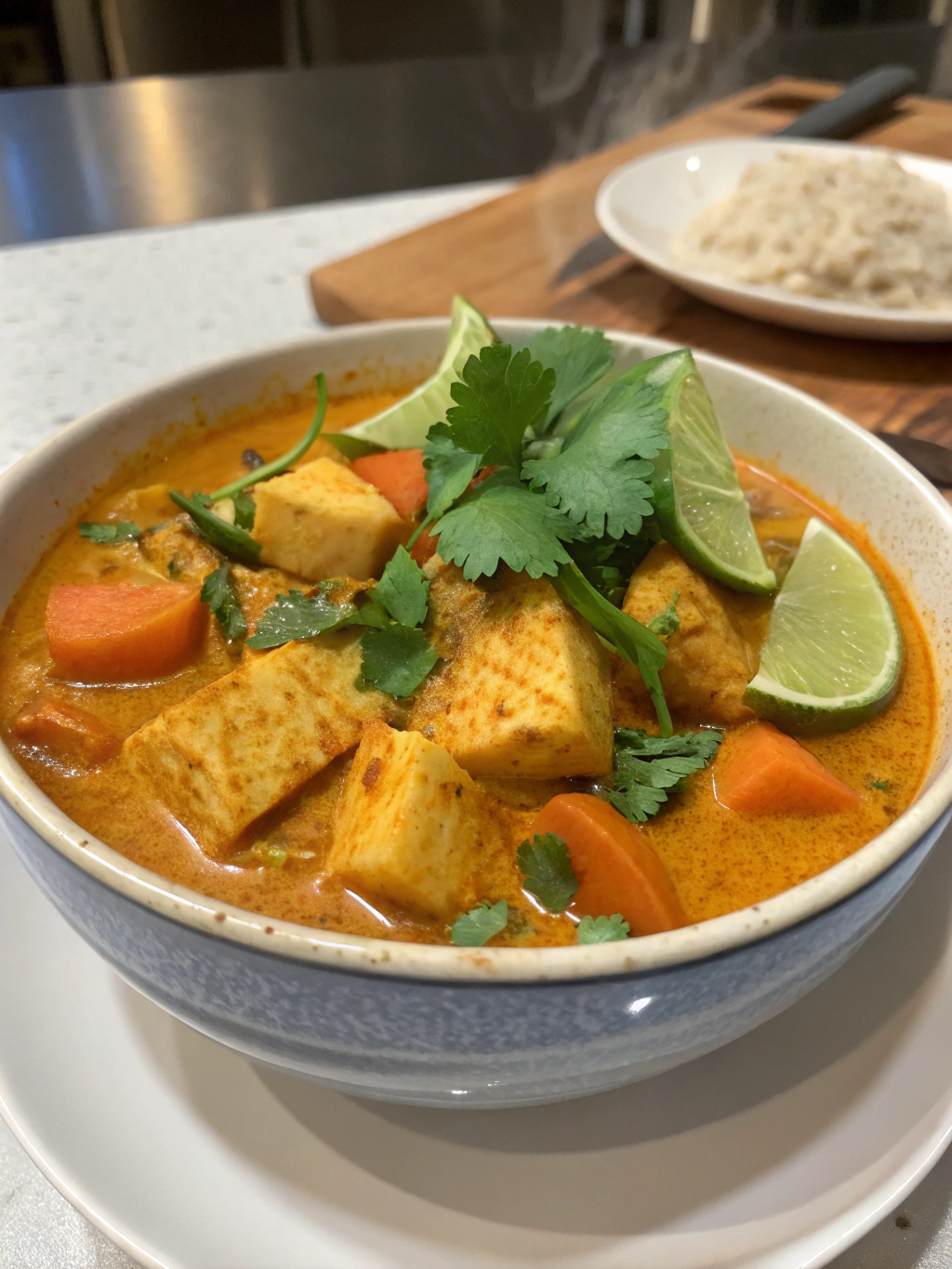
Fish Curry Vegan
Mastering a truly exceptional fish curry vegan is an incredibly rewarding culinary adventure. As we’ve explored through our five key approaches – selecting the right plant-based ‘fish’, perfecting the aromatic base, balancing the spice blend, infusing that crucial oceanic flavour, and employing the correct cooking techniques – creating a dish packed with depth, complexity, and authentic taste is well within your reach.
Gone are the days of bland vegan compromises; this recipe empowers you to craft a vibrant, creamy, and satisfying curry that celebrates the best of plant-based cooking, drawing inspiration from rich “Vegan curry recipes, Vegetarian fish alternatives, Plant-based spice blends” traditions. Remember the importance of fresh ingredients, patience in building flavour layers, and those final touches like fresh lime juice and cilantro that elevate the dish from good to unforgettable.
Now it’s your turn! We wholeheartedly encourage you to dive into this recipe, experiment with the different ‘vegan fish’ options, and adjust the spices to your liking. Discover the joy of creating a restaurant-quality vegan curry in your own kitchen.
We’d love to hear about your experience! Did you try the tofu, hearts of palm, or perhaps the banana blossom? What did you serve it with? Share your results, photos, and any personal twists in the comments below. Your feedback helps our community grow and inspires other home cooks. Happy cooking!
FAQs about Fish Curry Vegan
Here are answers to some frequently asked questions about making the perfect fish curry vegan:
Which vegan fish alternative tastes the most ‘realistic’?
- Texture-wise, banana blossom is often cited as having the flakiest texture, most closely mimicking cooked fish. Hearts of Palm also offer a good flake. Flavour realism comes mostly from the sauce and the added oceanic elements (nori, capers). Tofu excels at absorbing the curry flavour, while King Oyster Mushrooms offer a unique ‘meaty’ bite. Store-bought options vary greatly by brand. Experiment to find your personal favourite!
Can I make this curry oil-free?
- Yes! To make it oil-free, simply sauté the onions, garlic, and ginger in vegetable broth or water instead of oil. Add small amounts as needed to prevent sticking. You’ll also need to bloom the spices carefully with a splash of liquid. The final curry might be slightly less rich but still delicious.
Is this recipe gluten-free?
- The core ingredients (vegetables, spices, coconut milk, tofu, hearts of palm, banana blossom, mushrooms) are naturally gluten-free. However, you must ensure your vegetable broth and any store-bought vegan fish substitute are certified GF. Also, if you use soy sauce (e.g., in a tofu marinade), ensure it’s a gluten-free variety like tamari.
How can I adjust the spice level?
- To Increase Heat: Add more fresh green chilies (keeping seeds in), increase the cayenne pepper/red chili powder, or add a pinch of hotter chili powder like Kashmiri chili (also adds colour). You can also serve with a side of chili Rela or hot sauce.
- To Decrease Heat: Omit the fresh green chilies entirely, use less (or omit) cayenne/red chili powder. Ensure your garam masala blend isn’t overly spicy. You can add a dollop of vegan yogurt when serving to cool it down.
Can I prepare components of this dish ahead of time?
- Absolutely! As mentioned in the Storing Tips: Chop aromatics (onion, garlic, ginger) and any extra veggies 1-2 days ahead. Press tofu in advance. Measure spices. You can even make the entire curry sauce (without the ‘vegan fish’) up to 2 days ahead, refrigerate it, and then gently reheat and add the ‘fish’ before serving for a quicker meal assembly.
My coconut milk separated or looks curdled. What happened?
- This can sometimes happen if the coconut milk is boiled too vigorously or if acidic ingredients (like tomatoes or lime juice) are added too quickly to very hot milk, or sometimes due to the brand/stabilizers used. It’s usually just cosmetic and doesn’t affect taste much. To minimize risk: use full-fat coconut milk, simmer gently (don’t boil hard), and temper acidic ingredients by adding them gradually or slightly off-heat. If it does separate, sometimes whisking vigorously can help emulsify it again.
What are curry leaves and are they essential?
- Curry leaves are leaves from the curry tree (Murraya koenigii) and impart a unique, slightly citrusy, pungent aroma fundamental to many South Indian dishes. While not absolutely essential (the curry will still be tasty without them), they add a significant layer of authenticity. Fresh are best, found in Indian grocery stores. Dried ones are less potent. If unavailable, you can omit them or use a bay leaf (and remove it), though the flavour profile won’t be the same. They are not the same as curry powder.
Can I add other vegetables to this curry?
- Yes, definitely! This curry is very adaptable. Bell peppers, green beans, peas, spinach, kale, diced potatoes, or sweet potatoes make great additions. Add harder vegetables earlier (with the tomatoes/coconut milk) and leafy greens right at the end. This is a great way to add more nutrients and bulk up the meal.



